Nematode Parasites of Grape in Michigan
Fred Warner, Diagnostic Services
Introduction
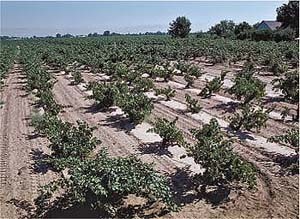
Grapes, Vitis sp., are hosts to many types of plant-parasitic nematodes. All the nematode species considered serious pathogens of grape feed on or within roots and quite frequently go undetected because their feeding does not result in the production of characteristic secondary (above ground) symptoms. In addition, some nematodes that occur on grape can vector important plant viruses. The majority of these nematodes occur worldwide wherever grapes are grown.
Vineyard sites should always be sampled for nematodes prior to establishment. This is critical because there are no longer any post-plant chemical control options for nematodes on grape, so control must be achieved before planting. Proper identification of the types of nematodes present in any location is imperative in order to design management plans especially if cultural tactics will be utilized.
Although the most serious nematode parasites of grape will be listed below, it is important to note vineyards typically contain three of more genera/species of plant-parasitic nematodes. Evidence suggests that the different nematodes may interact, causing greater reductions in growth and losses of yields than they do individually.
Historically, most of the research and surveys done for grape nematodes in Michigan involved V. lambrusca cv. Concord. However, as we try to attract more visitors to our state, wineries are becoming much more popular and prevalent and interspecific hybrids/varieties or cultivars of V. vinifera are typically used in the production of wine. The impacts of nematodes on these varieties have not been well documented in MI.
Root-knot Nematodes
Our state is home to the Michigan grape root-knot nematode, Meloidogyne nataliei, the only place in the World where this nematode is known to exist. It was originally found in Mattawan in 1977 and an attempt was made to eradicate it. It was later found associated with declining grapes near Lawton and as of the last survey conducted in 1990 dedicated to this nematode its worldwide distribution is limited to five sections (13, 14, 27, 34 & 35) of Antwerp and one section (7) of Porter Townships in Van Buren County. Growers, especially in SW MI, should be aware of its existence and the fact it is almost always found associated with unthrifty plants in vineyards. This nematode was detected again on the original farm in July 2012. We ask you please contact us, if on a nematode safari, you encounter this rare nematode as we would still like to monitor its distribution in MI.
The most common root-knot nematode found on grape in MI is the northern root-knot, M. hapla. In a study done in Lawton from 1987-1993 examining the impacts of 4 plant-parasitic nematodes on 10 French-American hybrid grapevine cultivars, the northern root-knot nematode reduced fruit yields of 5 of the 7 cultivars from which yields were collected. For comparison purposes, the American dagger nematode ranked second in yield loss potential in this study as it reduced yield of 2 of the 7 cultivars.
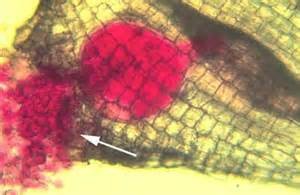
In 2010, inspectors for the Michigan Department of Agriculture and Rural Development collected nematode samples from 49 vineyards in a survey for the apple root-knot nematode, M. mali, which will also attack grape. Root-knot nematodes were recovered in 59% of those samples but only the northern root-knot nematode was positively identified.
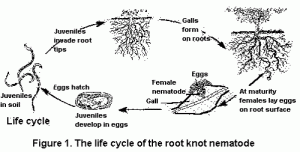
Damage by root-knot nematodes tends to be most severe in sandy soils and grapevines appear highly sensitive to feeding by these pathogens. Yields can be chronically and substantially decreased. Typically, feeding by root-knot nematodes results in the formation of galls on the roots of their hosts but northern root-knot nematodes produce very small galls in comparison to other species and on woody hosts, like grape, these galls are often inconspicuous. Feeding by the Michigan grape root-knot nematode does not result in gall formation but the eggs sacs produced by these nematodes are quite shiny and will glisten in the sun. The eggs sacs are a bit smaller than the size of a head of a straight pin.
Dagger and Needle Nematodes
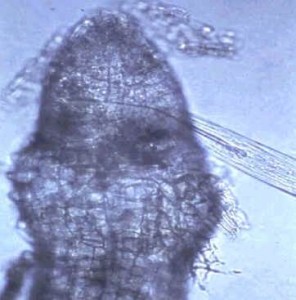
Dagger, Xiphinema sp., and needle nematodes, Longidorus sp., are important pathogens of grape but also can vector debilitating viruses. Of these two types of nematodes, dagger nematodes are far more important as the most common species in our state, X. americanum, can vector tobacco (TRSV) and tomato ringspot viruses (ToRSV) as well as peach rosette mosaic virus. Direct feeding by these nematodes can cause substantial growth reductions and reduced yields. The tips of roots are often attacked sometimes resulting in terminal swellings and a proliferation of roots behind these root caps. Needle nematodes typically are capable of causing significant yield losses of their hosts.
In a survey of 50 V. lambrusca vineyards in Southwest MI in 1978, the American dagger nematode was detected in 72% of them. It was the second most frequently detected plant-parasitic nematode behind ring nematodes which were found in 96% of the vineyards.
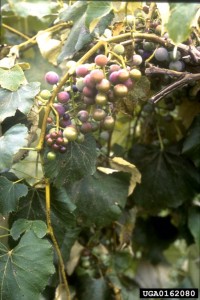
Lesion Nematodes
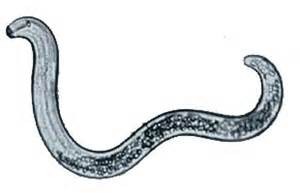
Lesion nematodes are pathogens of grapevine but they can also predispose roots to invasion by other plant pathogens. They penetrate roots and migrate throughout cortical cells often killing them. The microscopic lesions produced on the surfaces of roots can be utilized by fungi, in particular, to invade root tissues. Lesion nematode-infected plants often have reduced root masses and volumes.
Ring Nematodes
Ring nematodes are possibly the most frequently detected of all the plant-parasitic nematodes in vineyards. Their feeding can result in the stunting of grapevines and evidence suggests grapes infested with ring nematodes are possibly more prone to winter injury.
Nematode Management
To effectively manage plant-parasitic nematodes, it is imperative they are properly identified. This is due to the following facts: nematodes do not all share the same host plants; they behave differently; they vary tremendously in their reproductive potentials; life expectancies and differ in their virulences (the amounts of disease they cause) on grape. Plus, some can vector plant viruses while most don’t.
It is critical future vineyard sites are sampled for nematodes prior to establishment. As mentioned in the introduction, there are no post-plant chemical control options for these pathogens in established plantings. In a study in California, it was demonstrated that cumulative grape yield in untreated control plots was 22-29% lower than when compared against the most effective treatment. Grapes will yield better if protected from nematodes early in their establishment.
Hobby wine makers and other vintners may not be interested in maximizing yields in their vineyards. In these cases, nematode management is probably not a serious priority. Grapevine will tolerate feeding by many plant-parasitic nematodes and nematodes, if acting alone, typically do not kill their hosts. However, even in situations where maximizing tonnage is not a yield goal, nematodes can negatively impact grape quality. Plus, all growers should strive to avoid viruses as they typically are very debilitating and can drastically shorten the lives of vines.
The presence of American dagger nematodes is always a concern in sites where vineyards will be established because they are the most frequently detected species of plant-parasitic nematodes in MI capable of vectoring viruses. Only one dagger nematode is needed to transmit a virus from an infected vine or weed (maybe more likely) to a healthy vine. Collecting soil samples are required to assess population densities of dagger nematodes and subsequently to assign risk to a future grape planting. Unfortunately, we do not have the ability in Diagnostic Services at this time to detect viruses in the nematodes, so other risk factors must be considered.
When trying to determine action for future vineyard sites, a few questions should be asked: 1) Have grapes or any other fruit crops been grown here in the past? 2) Are broadleaf weeds, especially dandelion present? Dandelions are symptomless carriers of ringspot viruses. Dandelions can be tested for viruses and if they are detected it is almost certain that grapes grown on the site will also eventually become infected. 3) Have viruses been detected on this site in the past or were virus-like symptoms observed if fruit was grown?
If the answer to any of the three questions is “yes,” it is imperative soil and root samples are collected and analyzed for dagger nematodes. If dagger nematodes are recovered, their control is recommended. This can be achieved by soil fumigation, growing rapeseed cv. Dwarf Essex for 1 or 2 years, or by growing grasses for 2 years utilizing strict broadleaf weed control. Although grasses can host dagger nematodes, viruses are not passed onto their offspring as they must be acquired by feeding. Therefore, if broadleaf weeds are eliminated, the young nematodes cannot acquire viruses unless provided with infected plants. Dagger nematodes can survive 2 years or more, so growing grasses for two years almost ensures all the adults with viruses die and the young nematodes have no virus sources. Always initiate plantings with virus-free planting material, especially if you have already incurred the time and expense of dagger nematode control. Dagger nematodes can also be controlled by allowing the ground to remain fallow and working it constantly. Dagger nematodes do not like disturbance. However, they are prone to migrating to depths of 2-3 feet in the soil to escape dry, hot soils. It is also important to keep in mind that all plant-parasitic are usually distributed in the rooting zone of the previous host. If an old vineyard is being replaced, dagger nematodes can be found at the deepest depths that those roots penetrated.
Soil fumigation is the only tactic that will provide good to excellent control of all plant-parasitic nematodes. Effective uses of non-chemical control measures/cultural tactics require a greater understanding of nematode biologies, distributions, hosts, etc. For example, for dagger nematode management, the use of rapeseed cv. Dwarf Essex was suggested. However, rape is typically a very good host for lesion nematodes and can also host northern root-knot nematodes. Population densities of northern root-knot nematodes can be reduced by growing grasses but they are very good hosts for dagger and lesion nematodes. Forage legumes are typically good to excellent hosts for lesion, northern root-knot and ring nematodes. Mustards are also good hosts for lesion and northern root-knot nematodes. Lesion nematodes can be managed by growing pearl millet but it is a host for dagger nematodes. Know your nematodes.
Integrated nematode management can get a bit complicated. Successful control of plant-parasitic nematodes requires their proper identification in order to design a customized management plan. Post-plant control options are even more limited.
If you suspect you have grapevines infected with viruses, leaf tissues should be collected and sent to a lab for positive identification of the viruses. Some virus testing can be done at MSU either in Diagnostic Services or another lab but samples for virus identification can always be sent to AgDia in Elkhart, IN (www.agdia.com). If viruses are positively identified, infected grapevines and 3-5 neighboring vines should be removed from the vineyard and destroyed including as many roots at possible. These areas should then be spot-treated for dagger nematodes using any of the control tactics provided above.
Steps should be taken to try to keep the soils in vineyards as healthy as possible. Plants grown in healthy soils will withstand nematode feeding better. As a general rule of thumb, as soil organic matter increases, the diversity and abundance of beneficial organisms in the soil do too.
Conclusions
Avoidance of plant-parasitic nematodes should be a goal of all grape growers. However, this is much easier said than done as nematodes are the most numerous animals on our planet. If you want to avoid a problem in a future vineyard or suspect you have one in a current planting, it is advised you collect root and soil samples and submit them to Plant and Pest Diagnostics for nematode analyses. Based on the results obtained, we will provide a management plan(s). To ask questions or address concerns regarding sampling or all things nematode, please contact Angela Tenney at 517-353-8563.



 Print
Print Email
Email




